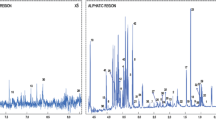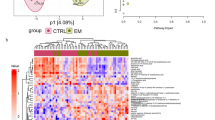Abstract
Purpose
The purpose of this study was to investigate alterations in serum metabolites during endometrial transformation and possible associations with recurrent implantation failure (RIF) in hormonal replacement therapy (HRT)-frozen embryo transfer (FET) cycles.
Methods
We performed a prospective study involving 100 patients scheduled for HRT-FET cycles during January 2022 to April 2022. Blood serum samples were collected on the day of progesterone administration (dPA) and on the third day of progesterone administration (d3PA). Gas chromatography-mass spectrometry (GC-MS) analysis was performed to identify and quantify serum metabolites. A nested case-control study including 19 RIF patients and 19 matching controls was conducted to explore the predictive value of serum metabolites for RIF. Partial least squares discriminant analysis (PLS-DA) and receiver operating characteristic (ROC) curve analysis were performed to establish prediction models.
Main results
We identified 105 serum metabolites, with 76 of them exhibiting significant alterations during the initial 3 days of endometrial transformation. Metabolites involved in amino acid metabolism and tricarboxylic acid (TCA) cycle showed lower levels during endometrial transformation. In the nested case-control study, the prediction model based on the ratio of serum metabolites between d3PA and dPA showed the highest area under the ROC curve (AUC), accuracy, and R2 and Q2 values. Eight metabolites, including indol-3-propionic acid, beta-alanine, myristoleic acid, malic acid, indole, DL-isocitric acid, proline, and itaconic acid, exhibited high predictive values for RIF.
Conclusion
This study demonstrates alterations in serum metabolites during endometrial transformation, particularly in amino acid metabolism and TCA cycle. The identified metabolites, especially indol-3-propionic acid and malic acid, show potential as predictive markers for RIF. These findings contribute to a better understanding of the metabolic changes associated with endometrial receptivity and provide insights for the development of personalized approaches to improve implantation outcomes in FET cycles.





Similar content being viewed by others
Data availability
All data generated or analyzed during this study are included in this published article.
References
Ombelet W, Cooke I, Dyer S, Serour G, Devroey P. Infertility and the provision of infertility medical services in developing countries. Hum Reprod Update. 2008;14:6.
Mumusoglu S, Polat M, Ozbek IY, Bozdag G, Papanikolaou EG, Esteves SC, et al. Preparation of the endometrium for frozen embryo transfer: a systematic review. Front Endocrinol (Lausanne). 2021;12:688237.
Labarta E, Mariani G, Paolelli S, Rodriguez-Varela C, Vidal C, Giles J, et al. Impact of low serum progesterone levels on the day of embryo transfer on pregnancy outcome: a prospective cohort study in artificial cycles with vaginal progesterone. Hum Reprod. 2021;36:3.
Labarta E, Sebastian-Leon P, Devesa-Peiro A, Celada P, Vidal C, Giles J, et al. Analysis of serum and endometrial progesterone in determining endometrial receptivity. Hum Reprod. 2021;36:11.
Psychogios N, Hau DD, Peng J, Guo AC, Mandal R, Bouatra S, et al. The human serum metabolome. PLoS One. 2011;6:2.
Buergel T, Steinfeldt J, Ruyoga G, Pietzner M, Bizzarri D, Vojinovic D, et al. Metabolomic profiles predict individual multidisease outcomes. Nat Med. 2022;28:11.
Dutta M, Singh B, Joshi M, Das D, Subramani E, Maan M, et al. Metabolomics reveals perturbations in endometrium and serum of minimal and mild endometriosis. Sci Rep. 2018;8:1.
Yan X, Zhao W, Wei J, Yao Y, Sun G, Wang L, et al. A serum lipidomics study for the identification of specific biomarkers for endometrial polyps to distinguish them from endometrial cancer or hyperplasia. Int J Cancer. 2022;150:9.
Pirtea P, Scott RT Jr, de Ziegler D, Ayoubi JM. Recurrent implantation failure: how common is it? Curr Opin Obstet Gynecol. 2021;33:3.
Mahajan N. Endometrial receptivity array: clinical application. J Hum Reprod Sci. 2015;8:3.
Ruiz-Alonso M, Blesa D, Diaz-Gimeno P, Gomez E, Fernandez-Sanchez M, Carranza F, et al. The endometrial receptivity array for diagnosis and personalized embryo transfer as a treatment for patients with repeated implantation failure. Fertil Steril. 2013;100:3.
Hu S, Yao G, Wang Y, Xu H, Ji X, He Y, et al. Transcriptomic changes during the pre-receptive to receptive transition in human endometrium detected by RNA-Seq. J Clin Endocrinol Metab. 2014;99:12.
Liu Y, Yao Y, Sun H, Zhao J, Li H, Wang S, et al. Lipid metabolism-related genes as biomarkers and therapeutic targets reveal endometrial receptivity and immune microenvironment in women with reproductive dysfunction. J Assist Reprod Genet. 2022;39:9.
Yang T, Zhao J, Liu F, Li Y. Lipid metabolism and endometrial receptivity. Hum Reprod Update. 2022;28:6.
Smart KF, Aggio RB, Van Houtte JR, Villas-Boas SG. Analytical platform for metabolome analysis of microbial cells using methyl chloroformate derivatization followed by gas chromatography-mass spectrometry. Nat Protoc. 2010;5:10.
Gao S, Long F, Jiang Z, Shi J, Ma D, Yang Y, et al. The complex metabolic interactions of liver tissue and hepatic exosome in PCOS mice at young and middle age. Front Physiol. 2022;13:990987.
Braga D, Borges E Jr, Godoy AT, Montani DA, Setti AS, Zanetti BF, et al. Lipidomic profile as a noninvasive tool to predict endometrial receptivity. Mol Reprod Dev. 2019;86:2.
Mirabi P, Chaichi MJ, Esmaeilzadeh S, Ali Jorsaraei SG, Bijani A, Ehsani M, et al. The role of fatty acids on ICSI outcomes: a prospective cohort study. Lipids Health Dis. 2017;16:1.
Ruiz-Sanz JI, Perez-Ruiz I, Meijide S, Ferrando M, Larreategui Z, Ruiz-Larrea MB. Lower follicular n-3 polyunsaturated fatty acid levels are associated with a better response to ovarian stimulation. J Assist Reprod Genet. 2019;36:3.
Zarezadeh R, Nouri M, Hamdi K, Shaaker M, Mehdizadeh A, Darabi M. Fatty acids of follicular fluid phospholipids and triglycerides display distinct association with IVF outcomes. Reprod Biomed Online. 2021;42:2.
Azkargorta M, Escobes I, Iloro I, Osinalde N, Corral B, Ibanez-Perez J, et al. Differential proteomic analysis of endometrial fluid suggests increased inflammation and impaired glucose metabolism in non-implantative IVF cycles and pinpoints PYGB as a putative implantation marker. Hum Reprod. 2018;33:10.
Furman D, Campisi J, Verdin E, Carrera-Bastos P, Targ S, Franceschi C, et al. Chronic inflammation in the etiology of disease across the life span. Nat Med. 2019;25:12.
Monsivais D, Nagashima T, Prunskaite-Hyyrylainen R, Nozawa K, Shimada K, Tang S, et al. Endometrial receptivity and implantation require uterine BMP signaling through an ACVR2A-SMAD1/SMAD5 axis. Nat Commun. 2021;12:1.
Liu Z, Tang Y, Qiu T, Cao X, Clemens TL. A dishevelled-1/Smad1 interaction couples WNT and bone morphogenetic protein signaling pathways in uncommitted bone marrow stromal cells. J Biol Chem. 2006;281:25.
Fang Y, Liu Z, Chen Z, Xu X, Xiao M, Yu Y, et al. Smad5 acts as an intracellular pH messenger and maintains bioenergetic homeostasis. Cell Res. 2017;27:9.
Shapiro SS, Johnson MH Jr. Progesterone altered amino acid accumulation by human endometrium in vitro. Biol Reprod. 1989;40:3.
Simintiras CA, Sanchez JM, McDonald M, Martins T, Binelli M, Lonergan P. Biochemical characterization of progesterone-induced alterations in bovine uterine fluid amino acid and carbohydrate composition during the conceptus elongation window. Biol Reprod. 2019;100:3.
Sawai A, Tsuzuki K, Yamauchi M, Kimura N, Tsushima T, Sugiyama K, et al. The effects of estrogen and progesterone on plasma amino acids levels: evidence from change plasma amino acids levels during the menstrual cycle in women. Biol Rhythm Res. 2020;51:1.
Wikoff WR, Anfora AT, Liu J, Schultz PG, Lesley SA, Peters EC, et al. Metabolomics analysis reveals large effects of gut microflora on mammalian blood metabolites. Proc Natl Acad Sci U S A. 2009;106:10.
Chimerel C, Emery E, Summers DK, Keyser U, Gribble FM, Reimann F. Bacterial metabolite indole modulates incretin secretion from intestinal enteroendocrine L cells. Cell Rep. 2014;9:4.
Abildgaard A, Elfving B, Hokland M, Wegener G, Lund S. The microbial metabolite indole-3-propionic acid improves glucose metabolism in rats, but does not affect behaviour. Arch Physiol Biochem. 2018;124:4.
Mills EL, Ryan DG, Prag HA, Dikovskaya D, Menon D, Zaslona Z, et al. Itaconate is an anti-inflammatory metabolite that activates Nrf2 via alkylation of KEAP1. Nature. 2018;556:7699.
Lampropoulou V, Sergushichev A, Bambouskova M, Nair S, Vincent EE, Loginicheva E, et al. Itaconate links inhibition of succinate dehydrogenase with macrophage metabolic remodeling and regulation of inflammation. Cell Metab. 2016;24:1.
Acknowledgements
The authors express our gratitude to Yu Dai, Hongyu Liu, and Jianru Yang for collection and handling of the serum samples.
Funding
This study was supported by the National Natural Science Foundation of China (82101710), Chongqing medical scientific research project (Joint project of Chongqing Health Commission and Science and Technology Bureau, 2022QNXM023), Natural Science Foundation of Chongqing (cstc2021jcyj-msxmX0097), Strategic Collaborative Research Program of the Ferring Institute of Reproductive Medicine, Ferring Pharmaceuticals and Chinese Academy of Sciences (FIRMD200502), and the Kuanren Talents Program of the Second Affiliated Hospital of Chongqing Medical University.
Author information
Authors and Affiliations
Contributions
SZ conceived and designed the study. JZ and XT performed the experiments. JZ, XT, TH, and SZ analyzed the data and created the figures. SZ and JZ drafted and reviewed the manuscript.
Corresponding author
Ethics declarations
Ethics approval
This study was approved by the Ethics Committees of the Second Affiliated Hospital of Chongqing Medical University (2021-228). Written informed consent was obtained from all the participants.
Conflict of interest
The authors declare no competing interests.
Additional information
Publisher’s note
Springer Nature remains neutral with regard to jurisdictional claims in published maps and institutional affiliations.
Rights and permissions
Springer Nature or its licensor (e.g. a society or other partner) holds exclusive rights to this article under a publishing agreement with the author(s) or other rightsholder(s); author self-archiving of the accepted manuscript version of this article is solely governed by the terms of such publishing agreement and applicable law.
About this article
Cite this article
Zheng, J., Tang, X., Han, Tl. et al. Metabolomics analysis of serum metabolites during endometrial transformation: association with recurrent implantation failure in hormonal replacement therapy-frozen embryo transfers cycles. J Assist Reprod Genet 40, 2473–2483 (2023). https://doi.org/10.1007/s10815-023-02904-x
Received:
Accepted:
Published:
Issue Date:
DOI: https://doi.org/10.1007/s10815-023-02904-x




